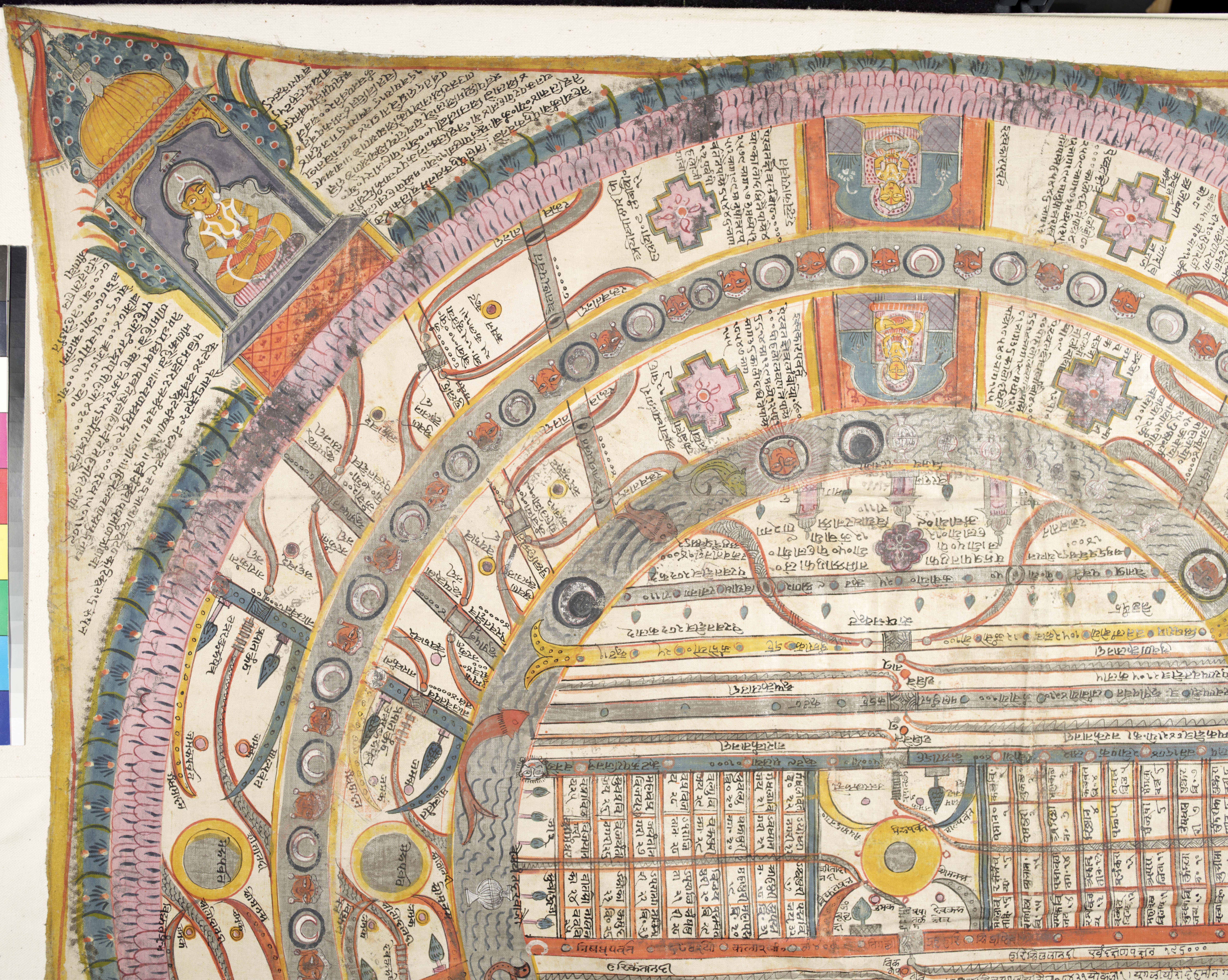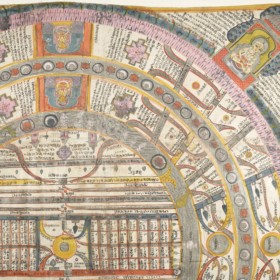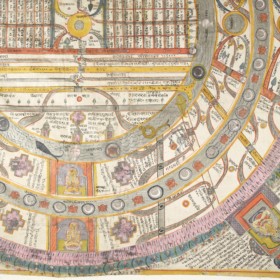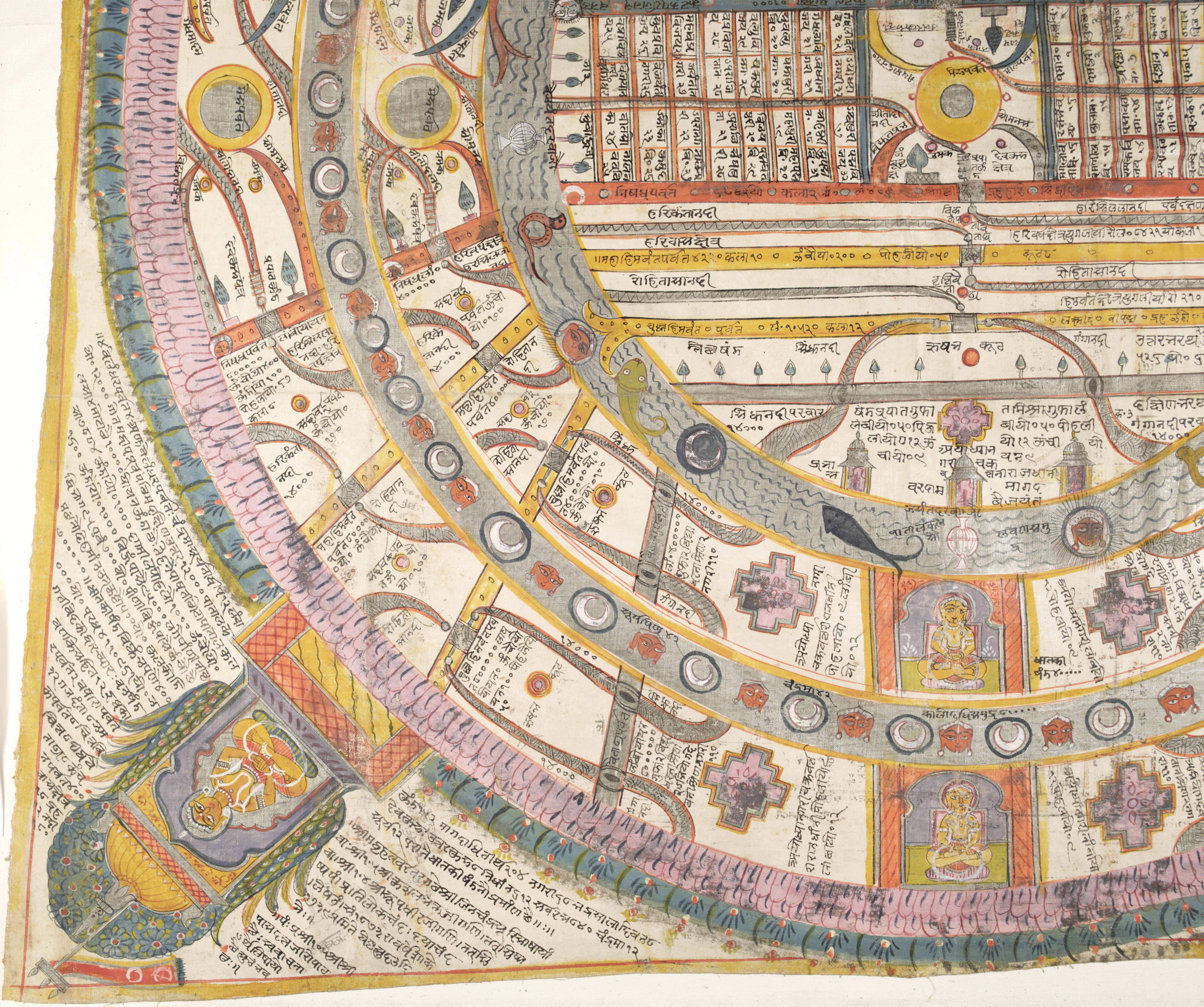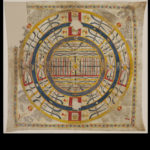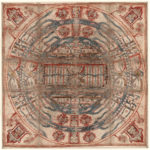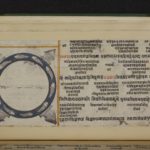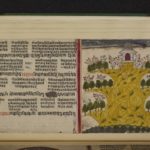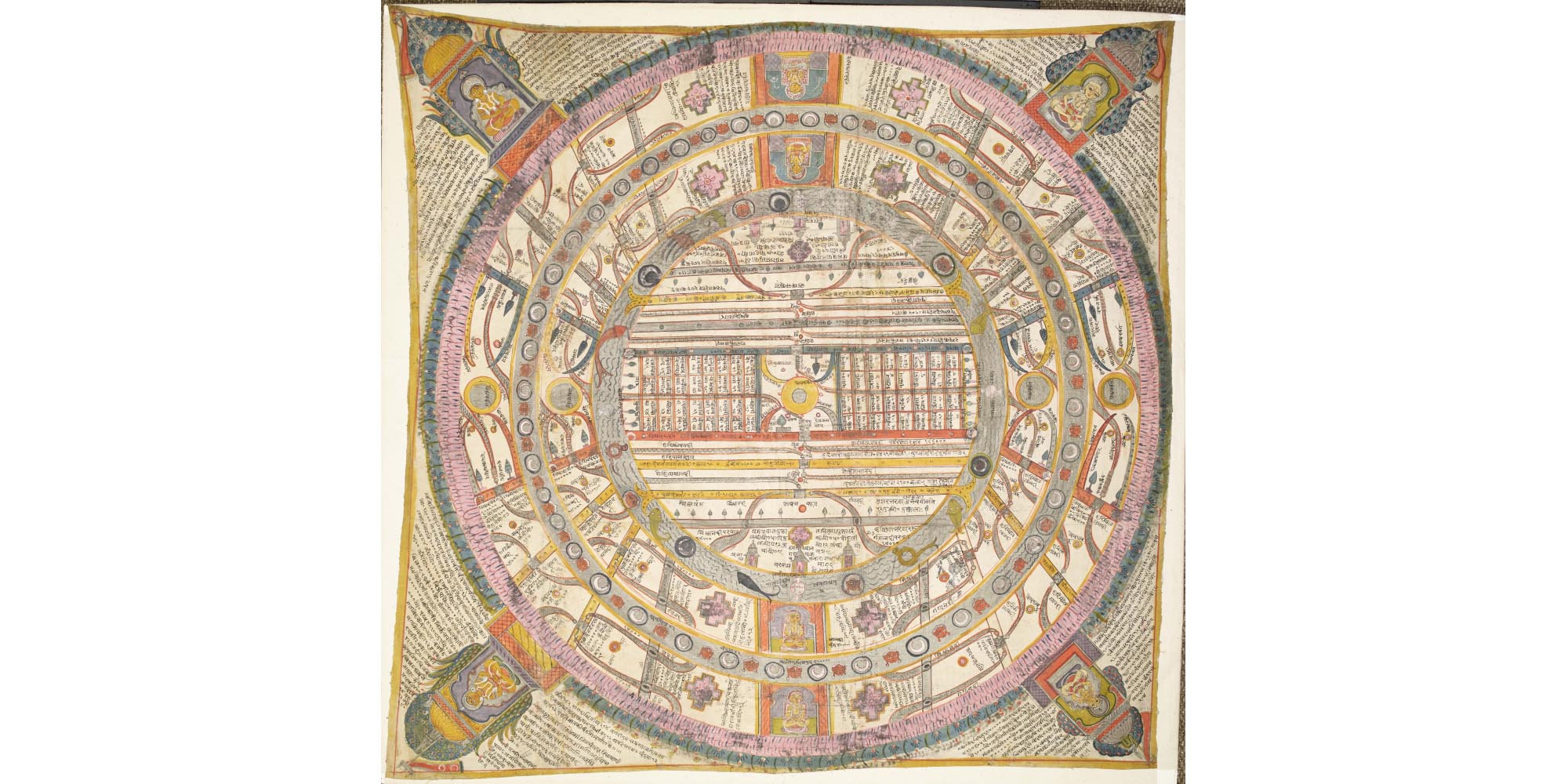
Background
The Royal Asiatic Society was presented with this painting by Major-General William Miles on 17th June 1837. It had been given to him ‘by a Jain Priest of the Province of Marwar’ (see Head 1991). Besides his official activities in the army, Major-General Miles showed interest in the Jains, demonstrated by his contribution entitled ‘On the Jains of Gujerat and Marwar’ (Transactions of the Royal Asiatic Society III, 1835: 335–371). F. E. Pargiter published the first description of this Two and A Half Continents painting in 1916 (see Pargiter 1916) in the Journal of the Royal Asiatic Society.
Aḍhāī-dvīpa is the Hindi phrase for ‘Two and A Half Continents’ and describes the only part of the universe where human beings live in the Middle World of Jain cosmology. Frequently depicted in maps or colourful diagrams, it is the only part of the universe where people can be born so it is also known as ‘the World of Humans’ – manuṣya-loka.
The Two and A Half Continents is formed of concentric rings of differing size. Every other ring is a continent, which is surrounded by a ring of ocean. Moving from the centre outwards, the order is as follows:
- the central continent, called Jambū-dvīpa
- the first ocean, known as Lavaṇa-samudra or ‘Salt-Ocean’
- the second continent, Dhātakīkhaṇḍa
- the second ocean, called Kālodadhi or ‘Black-water Ocean’
- half of the third continent known as Puṣkara-dvīpa.
Mount Meru is the centre of the universe in Jain cosmology, at the heart of the central continent of Jambū-dvīpa. Jambū is where human beings live and is in the Middle World, one of the three worlds of traditional Jain cosmology.
The Middle World is the smallest of the three worlds that make up world space – loka-ākāśa. In world space all the souls live in the different body-forms they take according to their rebirths, in the various worlds. Outside world space is the non world space – aloka-ākāśa – which is endless. However, the Middle World is the most important area from the spiritual point of view because it is the only part where human beings can live.
Pictures in cosmological works are not intended to be merely attractive. Spelling out in visual form the complex explanations found in the writings, cosmological paintings form a long-established tradition of artwork in Jain heritage.
Jains cannot advance spiritually without understanding and meditating upon cosmological theories so understanding them is crucial. Certain key religious concepts run through these theories. These include the notion of a physical soul shedding karma by moving through the cycle of rebirth to eventual omniscience and final liberation, along with the cyclical nature of time, the interconnectedness of the universe, and the importance of symmetry, repetition and balance.
Transcription
In the bottom-left corner, the text on the right side of the temple with a Jina, provides information that is found in the colophons of manuscripts. The first few lines are additional detail about the Jain universe, provided on the description tab.
From line 4 onwards, it gives the date and the name of the person who wrote, and perhaps painted, the object and of the owner.
4. // śrī // Br̥hat-Kharatara-gache śrī-Jinacandrasūri-ācārya-
5. vā° śrī-105-śrī-Kuśalabhaktajī-gaṇi / tat-śiṣya
6. vā°/ śrī-104-śrī-Rūpadhīrajī-gaṇi / tat-si-
7. ṣya paṃ°/ pra°/ Tilokacaṃdaḥ Dayācaṃda
8. liṣataṃ / saṃ 1873 rā varṣe Śāke 1739 pramite Yeṣṭha suda 3 di-
9. ne //
10. // paṃ pra śrī-105-śrī-śrī-
11. Pāsadattajī ro pāṭa chai sva-vācanā-
12. rthe liṣāyo
13. che subhaṃ bhava-
14. tu.
Translation
Written by Pandit Tilokacanda Dayācanda, pupil of the group-leader, the teacher Rūpadhīra, himself pupil of the group-leader, the respected teacher Kuśalabhakta, pupil of Jinacandra-sūri of the monastic order the Large Kharatara. The third day of the bright half of the year 1873 in the Vikrama era, 1739 in the Śāka era.
This is the painted cloth of Pandit Pāsadatta. It was created for him to read. May there be auspiciousness!
Remarks
The language is Sanskrit, mixed with Rajasthani. The words rā and ro mean ‘of’ in this language.
The numbers 105 and 104 accompanying the honorific title śrī, which is used with the proper name of a religious teacher, are auspicious. The number 108 may also be used in the same way.
The Br̥hat-Kharatara-gaccha is one of the main Śvetāmbara monastic orders. Arising in the 12th century, this sect is active today and is largely represented in Rajasthan or Gujarat.
In the long history of this monastic order there have been several heads with the name Jinacandra-sūri. This one is probably the Jinacandra-sūri who was born in 1752 and died in 1799 (1809–1856 of the Vikrama era). Thus he had died before this aḍhāī-dvīpa was made.
The date is expressed according to the traditional Indian calendar. Here the year is indicated in two different eras, namely the:
- first one refers to 1873 in the Vikrama era
- second one to 1739 in the Śāka era.
The complete date as given in the document corresponds to 19 May 1817 in the Common Era (Pargiter 1916: 539).
The word pāṭa is the technical name for paintings on cloth or paper that are meant to be rolled so they can be carried.
The final phrase is customary at the end of manuscripts.
Glossary
Description
This is the traditional representation of the world inhabited by human beings in Jain cosmology. It is made up of alternate concentric rings of continents, mountains and oceans.
Like any map, this one has captions, which are of two types:
- geographical features, for example nadī for 'river', kūṭa for ‘mountain peak’
- proper names, for example Ayodhyā is the name of a town and Raktāvatīnadī is the name of a river.
Each part of the Jain world has named rivers, mountains, towns, caves and so on. Since symmetry and repetition are two of the major organising principles of the Jain world, the names are often the same in different regions.
At each of the four angles of the picture is a Jain temple with worshippers. This is intended to show that the Jinas' teachings are everywhere in the world.
On each side of these temples, there are lines of text written in small script. They provide additional detail about the Jain universe, describing each component, giving dimensions and occasional quotations from scriptures.
|
Location in painting |
Details |
|---|---|
|
Bottom left-hand corner:
|
|
|
Bottom right-hand corner |
measurements of Kālodadhi and Puṣkara-dvīpa |
|
Top right corner |
information about:
|
|
Top left corner |
measurements of the Lavaṇa-samudra |
Two and A Half Continents
The outermost pale pink ring is a mountain range called Mānuṣottara. It symbolises the limit beyond which human beings cannot live.
The two textured grey rings represent two oceans. The innermost one is the ocean called Lavaṇa-samudra – 'Salt Ocean'. The second one is Kālodadhi – 'Black-Water Ocean'.
The three spaces in between these three rings form the human world, which is called Aḍhāī-dvīpa – 'Two and A Half Continents'. Starting from the centre, they are:
- Jambū-dvīpa – 'Rose-apple Tree Island'
- Dhātakīkhaṇḍa
- Puṣkara-dvīpa – 'Lotus Island'.
Half of Puṣkara-dvīpa is in the world of humans while half is the other side of the mountain range marked by the pale pink circle. This is why the complete map of the human world is called 'Two and A Half Continents'.
The thick red vertical line divides the Dhātakīkhaṇḍa and the Puṣkara-dvīpa into two halves, eastern and western. There are four Jinas sitting within the line. The four segments of this line on land represent a mountain range known as Iṣvākāra – 'Arrow-like' – because it is perfectly straight. Its name is written on the lowest segment.
The five yellow disks going horizontally across the centre represent the central mountain, called Mount Meru. The Jambū-dvīpa has one in its middle while both the two other continents have identical Mount Merus in each half.
Either side of each Mount Meru are two semicircles, indicated by one green and yellow line, the other a red and white line. They are the boundaries of two regions. The northern one is called Uttara-kuru, the southern one Deva-kuru. These regions are the Lands of Enjoyment, where people get all they need from 'wishing trees' – kalpa-vṛkṣas – and do not need to make any effort. Couples made up of twin boys and girls live in the Lands of Enjoyment.
Jambū-dvīpa
The first continent, in the centre, is Jambū-dvīpa. It is divided into parts separated by mountain ranges.
From north to south there are eight mountain ranges. They are shown as double horizontal lines as they cross the Jambū-dvīpa from east to west. Here, the first and eighth are not coloured. The second, third, sixth and seventh are coloured in yellow. The most conspicuous on all maps are the fourth and fifth, respectively always green and red.
The names of all these mountains are not given in this map, but they are well known among Jains. Between these mountain ranges are seven regions. From north to south, the mountains and regions separating them are listed in the table.
|
Mountain ranges |
Regions |
|
|---|---|---|
|
1 |
Vaitāḍhya |
Airāvata |
|
2 |
Śikharin |
Hairaṇyavata – identified on the map |
|
3 |
Rukmin |
Ramyaka – identified on the map |
|
4 |
Nīla |
Mahā-videha – see below |
|
5 |
Niṣadha |
Harivarṣa |
|
6 |
Mahā-himavant |
Haimavata |
|
7 |
Himavant |
Bharata – identified on the map |
|
8 |
Vaitāḍhya |
Across the centre of Jambū is a large rectangular strip marked out by a green line in the north – the Nīla mountain range – and a red one in the south – the Niṣadha mountain range. This is the Mahā-videha, which has Mount Meru at its centre. The Mahā-videha is a land of wonders, where Cakravartins go and where Jinas preach.
The Mahā-videha is divided into 32 provinces, distributed as eight groups of four, equally in the north-east, south-east, north-west and south-west. They are always shown as small rectangles, like here.
Lavaṇa-samudra
The first ocean, starting from the centre, is the thick grey ring around Jambū. Called Lavaṇa-samudra, it has sets of pots in each of the four directions. These are the 'great receptacles' – pātāla-kalaśas – that cause the tides.
There are two horizontal yellow lines ending with double hook shapes shown in the north and south of this ocean. These are two mountain chains that end with double pairs of 'tusks' jutting out into Lavaṇa-samudra. These tusks carry the 56 islands known as Antara-dvīpas. The islands are divided into seven groups of eight, although they are not shown on this map.
Everywhere on this map, a multitude of grey rivers flows and irrigates the land. Small yellow circles are the islands of the moons and the suns, which vary in number from place to place.
- Source:
Royal Asiatic Society
- Shelfmark:
069.001
- Author:
Pandit Tilokacanda Dayacanda
- Date of creation:
1816
- Folio number:
not applicable
- Total number of folios:
1 large size
- Place of creation:
western India
- Language:
Rajasthani and Gujarati
- Medium:
gouache on cloth
- Size:
65.5 x 69.2 cm
- Copyright:
Royal Asiatic Society Images/RAS, London
- Image Copyright:
- +
- aAbhavya
- aAbhinandana
- aAbhiṣeka
- aĀcāra
- aĀcārāṅga-sūtra
- aĀcārya
- aAchalbhrata
- aAḍhāī-dvīpa
- aAdharma
- aAdho-loka
- aAdhyayana
- aAdvaita Vedānta
- aĀgama
- aAghātīya
- aAghātīya-karman
- aAgnibhuti
- aAgra
- aĀhāra
- aAhiṃsā
- aAhimsa Day
- aAjita
- aAjīva
- aAkampit
- aĀkāśa
- aAkbar the Great
- aAkṣaya-tṛtīyā
- aAlauddin Khalji
- aAlbert Einstein
- aAllah
- aAlms
- aĀlocanā
- aAloka-ākāśa
- aAmāri
- aAmbikā or Kūṣmāṇḍinī
- aAnagāra
- aAnanta
- aAnarthadaṇḍa
- aAnaśana
- aAnekānta-vāda
- aAṅga
- aAniconism
- aAnojjā
- aAntarāla
- aAntarāya-karma
- aAṇu
- aAṇu-vrata
- aAnukampā
- aAnuprekṣā
- aAnusvāra
- aApabhraṃśa
- aAparigraha
- aAra
- aĀrambha
- aĀrambhaja
- aĀratī
- aArdhamāgadhī Prākrit
- aArhaṃ
- aArhat
- aArśana-āvaraṇīya-karma
- aĀrta-dhyāna
- aĀryikā
- aĀryikā Jñānamati
- aĀśātanā
- aĀścarya
- aAscetic
- aAsceticism
- aAshram
- aAspiration
- aĀsrava
- aAṣṭa-maṅgala
- aAṣṭāpada
- aAstikāya
- aAstrolabe
- aAsura
- aAtheism
- aAticāra
- aAtiśayakṣetra
- aAtithisaṃvibhāgavrata
- aĀtma-vāda
- aĀtman
- aAuṃ
- aAurangzeb
- aAuspicious
- aAusterity
- aAvadhāna
- aAvadhi-jñāna
- aĀvaraṇī-yakarman
- aAvasarpiṇī
- aAvatāra
- aAvidyā
- aAxiom
- aĀyāga-paṭa
- aĀyambil
- aĀyu-karma
- aĀyurveda
- bBabur
- bBāhubali
- bBaladeva
- bBālāvabodha
- bBandha
- bBasadi
- bBazaar
- bBhadrankarvijay
- bBhagavant
- bBhaktāmara-stotra
- bBhakti
- bBhale
- bBharata
- bBhāṣā
- bBhāṣya
- bBhaṭṭāraka
- bBhāva
- bBhāva-pūjā
- bBhāvanā
- bBhavana-vāsin
- bBhavya
- bBhavyatva
- bBhaya
- bBhoga-bhūmi
- bBhogopabhoga
- bBodhi
- bBollywood
- bBrahmā
- bBrahma-deva
- bBrahmacārī
- bBrāhmaṇa
- bBraj Bhāṣā
- bBright fortnight
- bBritish Raj
- bBuddha
- bBuddhi-sagar
- bBuddhism
- bBuddhist
- cCaitya
- cCaityavāsin
- cCakravartin
- cCakreśvarī
- cCāmara
- cCandanā
- cCandragupta
- cCandraprabha
- cCanon
- cCāritra
- cCāritramohanīya-karman
- cCarũrī
- cCaste
- cCaturvidha-saṅgha
- cCaturviṃśati-stava
- cCāturyāma
- cCE
- cCelibacy
- cCha
- cChadmastha
- cChastity
- cCheda-sūtra
- cChristian
- cChristianity
- cClergy
- cCloning
- cColophon
- cCommentary
- cConch
- cConfession
- cCongregation
- cConsecration
- cCosmology
- cCremation
- cCrore
- cCult
- cCūrṇi
- dDādā-guru
- dDalit
- dDāna
- dDaṇḍa
- dDark fortnight
- dDarśana
- dDarśanamohanī-yakarman
- dDaśa-lakṣaṇa-parvan
- dDeity
- dDelhi Sultanate
- dDerāsar
- dDeśāvakāśika-vrata
- dDetachment
- dDevanāgarī
- dDevānandā
- dDevarddhi-gani
- dDevotee
- dDhamal
- dDhanuṣ
- dDhāra
- dDharma
- dDharma-dhyāna
- dDharma-sāgara
- dDharmastikaya
- dDhātakīkhaṇḍa
- dDholak
- dDhyāna
- dDiaspora
- dDig-vrata
- dDigambara
- dDīkṣā
- dDisciple
- dDīvālī
- dDivya-dhvani
- dDNA
- dDoctrine
- dDogma
- dDonor
- dDoṣa
- dDravya
- dDravya-pūjā
- dDrone
- dDuṣamā
- dDuṣamā-duṣamā
- dDuṣamā-suṣamā
- dDveṣa
- dDvīpa
- eEast India Company
- eEightfold Path
- eEkānta-vāda
- eEkendriya
- eElder
- eElders
- eEschatology
- eEtc up to
- fFarmān
- fFast
- fFatehpur Sikri
- fFestival
- fFestschrift
- fFiruz Shah
- fFly-Whisks
- fFolio
- fFour Noble Truths
- gGaccha
- gGaṇa
- gGaṇadhara
- gGanadharavada
- gGaṇeśa
- gGaṇin
- gGarba
- gGarbha
- gGarbha-gṛha
- gGaruḍa
- gGati
- gGene
- gGenomics
- gGhātī-yakarman
- gGhātīya
- gGhaznavid
- gGhiyasuddin Tughlaq
- gGhurid
- gGloss
- gGotra-karma
- gGujarāt
- gGujarati
- gGuṇa
- gGuṇa-sthāna
- gGuṇa-vrata
- gGupti
- gGuru
- gGuruṇī
- hHagiography
- hHajj
- hHaṃsa
- hHaribhadra
- hHariṇaigameṣin
- hHasta
- hHeresy
- hHiṃsā
- hHindi
- hHindu
- hHinduism
- hHīravijaya
- hHoroscope
- hHrīṃ
- hHumayun
- hHymn
- iIconoclasm
- iIconography
- iIdol
- iIndian Independence
- iIndology
- iIndra
- iIndrabhūti Gautama
- iIndriya
- iInitiation
- iIntercession
- iInvocation
- iIQ
- iIslam
- iIslamicate
- iIṣṭadevatā
- iĪśvara
- jJagat
- jJahangir
- jJain
- jJaina Devanāgarī
- jJaina Śaurasenī
- jJaina-dharma
- jJainaśāsana
- jJainness
- jJaisalmer
- jJamāli
- jJambū-dvīpa
- jJames Burgess
- jJanma
- jJanma-kalyāṇa
- jJarā
- jJāti
- jJina
- jJina-āgama
- jJina-bhavana
- jJina-bimba
- jJina-mātā
- jJinacandra-sūri
- jJinadatta
- jJinaprabha
- jJīva
- jJñāna
- jJñāna-āvaraṇīya-karma
- jJñāna-āvarṇiya
- jJñānsundar
- jJyotiṣka
- kKāla
- kKālakācārya-kathā
- kKālidāsa
- kKalpa-sūtra
- kKalpa-vṛkṣa
- kKalyāṇaka
- kKalyanvijay
- kKamaṇḍalu
- kKamaṭha
- kKarma
- kKarma-bhūmi
- kKarma-grantha
- kKarma-prakṛti
- kKarma-vāda
- kKarmon
- kKarnataka
- kKaṣāya
- kKathā
- kKāvya
- kKāya
- kKāyotsarga
- kKeśa-loca
- kKetu
- kKevala-jñāna
- kKevalin
- kKhalji
- kKharatara-gaccha
- kKnowledge
- kKriyā
- kKriyā-vāda
- kKṛṣṇa
- kKṣamā-śramaṇa
- kKṣapakaśreṇi
- kKṣatriya
- kKṣullaka
- kKulakara
- kKundakunda
- kKunthu
- lLabdhi
- lLaity
- lLakh
- lLāñchana
- lLands of Action
- lLaukāntika
- lLavaṇa-samudra
- lLeśyā
- lLiṅga
- lLinguistics
- lLoka
- lLoka-ākāśa
- lLoka-puruṣa
- lLoka-vāda
- lLotus
- lLotus lake
- mMadhya-loka
- mMahā-videha
- mMahā-vrata
- mMahābhārata
- mMahāmastakābhiṣeka
- mMāhārāṣṭra
- mMāhārāṣṭrī Prākrit
- mMahattarā Yākinī
- mMahāvīr Jayantī
- mMahāvīra
- mMakāra
- mMakkhali Gośāla
- mMalli
- mMāna-stambha
- mManaḥ-paryāya-jñāna
- mMaṇḍala
- mMaṇḍapa
- mMandit
- mMaṅgala
- mMantra
- mMantras
- mManuṣya-loka
- mMarāṭhī
- mMārgaṇā
- mMartyr
- mMarudevī
- mMaṭha
- mMati-jñāna
- mMauryaputra
- mMecca
- mMendicant lineage
- mMetarya
- mMiracle
- mMithyādṛṣṭi
- mMohandas Gandhi
- mMohanīya-karma
- mMokṣa
- mMonastic order
- mMonasticism
- mMonk
- mMonotheism
- mMosque
- mMount Meru
- mMount Sammeta
- mMṛgāvatī
- mMughal
- mMuhammad
- mMuhammad bin Tughlaq
- mMuhpattī
- mMūla-sūtra
- mMūlaguṇa
- mMumbaī
- mMuni
- mMunisuvrata
- mMurad Bakhsh
- mMūrti-pūjaka
- mMuslim
- mMysticism
- nNābhi
- nNāga-kal
- nNāgapurīya Tapā-gaccha
- nNāgarī
- nNāma-karma
- nNamaskāra-mantra
- nNami
- nNandīśvara-dvīpa
- nNandivardhana
- nNandyāvarta
- nNāraka
- nNāraki
- nNasalisation
- nNātha
- nNavrātrī
- nNaya-vāda
- nNemi
- nNidāna
- nniggaṃthāṇa vā 2
- nniggaṃtho vā 2
- nNigoda
- nNihnava
- nNikṣepa
- nNirgrantha
- nNirjarā
- nNirvāṇa
- nNiryukti
- nNiṣidhi
- nNitya
- nNiyati
- nNo-kaṣāya
- nNudity
- nNun
- oOcean of milk
- oOmniscience
- oOrdination
- ppa°
- pPadmaprabha
- pPadmāsana
- pPadmāvatī
- pPādukā
- pPalanquin
- pPalette
- pPañca-muṣṭi
- pPāṇḍava
- pPaṇḍit
- pPandit Dalsukh D. Malvania
- pPandit Sukhlalji
- pPāṇipātra
- pPāpa
- pParamātman
- pParameṣṭhin
- pPāraṇā
- pParigraha
- pPariṇāma
- pParīṣaha
- pParokṣa
- pPārśva
- pPārśvanātha
- pParyāya
- pParyuṣaṇ
- pPaṭa
- pPatan
- pPātra
- pPenance
- pPersian
- pPhala
- pPhilology
- pPicchikā
- pPilgrimage
- pPīr
- pPolymath
- pPoṣadha
- pPossession
- pPothī
- pPrabhas
- pPradakṣiṇā
- pPradeśa
- pPrākāra
- pPrakīrṇaka-sūtra
- pPrākrit
- pPramāda
- pPramukhā
- pPrati-vāsudeva
- pPratikramaṇa
- pPratimā
- pPratiṣṭhā
- pPratyākhyāna
- pPratyakṣa
- pPravacana
- pPrāyaścitta
- pPrayer
- pPre-modern
- pPreach
- pPredestination
- pProtestant
- pProvenance
- pPudgala
- pPūjā
- pPujārī
- pPukharavara-dvīpa
- pPuṇya
- pPūrva
- pPuṣkara-dvīpa
- pPuṣpadanta
- pPyre
- qQur’an
- rRāga
- rRāhu
- rRainy season
- rRajasthan
- rRajasthani
- rRājimatī
- rRajoharaṇa
- rRajput
- rRāma
- rRāmāyaṇa
- rRangoli
- rRās-garbā
- rRasa
- rRathanemi
- rRatna-traya
- rRātri-bhojana
- rRaudra-dhyāna
- rRecto
- rRelic
- rRenunciation
- rRetroflex
- rRevatī
- %Ṛg-veda
- rRite
- rRosary
- %Ṛṣabha
- %Ṛṣabhanātha
- rRupee
- sSaciyā Mātā
- sSādhu
- sSādhvī
- sSāgāra
- sSaint
- sŚaivaism
- sŚaka-saṃvat
- sSallekhanā
- sŚalya
- sSamacatuṣṭha
- sSamādhimaraṇa
- sSamaṇi
- sSāmarambha
- sSamavasaraṇa
- sSāmāyika
- sSaṃbhava
- sSamiti
- sSaṃjñā
- sSaṃkalpaja
- sSaṃsāra
- sSamudghāta
- sSaṃvara
- sSaṃvega
- sSamyak-cāritra
- sSamyak-darśana
- sSamyak-jñāna
- sSamyaktva
- sSaṃyama
- sSanctuary
- sSandalwood
- sSaṇgha
- sSanskrit
- sSant
- sŚānti
- sSapta-bhaṅgi-naya
- sSārambha
- sSarasvatī
- sSarvajña
- sSāsan-devi
- sŚāsana-devatā
- sŚāstra
- %Ṣaṭ-jīvanikāya
- sSatī
- sSatīmātā
- sSatya
- sSchism
- sScribe
- sScripture
- sSect
- sSecularism
- sŚenāī
- sSermon
- sŚeṣavatī
- sSevā
- sSeven fields of donation
- sShah Jahan
- sShantidas Jhaveri
- sShrine
- sSiddha
- sSiddha-śilā
- sSiddhacakra or Navadevatā
- sSiddhānta
- sSiddhārtha
- sSiddhi
- sSikh
- sSikhism
- sŚikṣā-vrata
- sŚīla
- sSin
- sSindh
- sŚītala
- sŚiva
- sSkandha
- sSomanatha
- sŚraddhā
- sŚramaṇa
- sŚrāvaka
- sŚrāvakācāra
- sŚrāvikā
- sŚreyāṃsa
- sŚrī
- sŚrīvatsa
- sŚruta-jñāna
- sŚruta-pañcamī
- sSthānaka-vāsin
- sSthāpanācārya
- sSthāvara
- sSthavira
- sSthiti
- sStrīmukti
- sStūpa
- sSubcontinent
- sSudarshana
- sŚuddhi
- sSudharma
- sŚūdra
- sSufism
- sSukha
- sŚukla-dhyāna
- sSulasā
- sSultan
- sSumati
- sSundarśrī
- sSupārśva
- sSūri
- sSuṣamā
- sSuṣamā-duṣamā
- sSuṣamā-suṣamā
- sSūtra
- sSuyam me ausam! Tenam bhagavaya evamakkhayam
- sSvādhyāya
- sSvāhā
- sSvastika
- sŚvetāmbara
- sŚvetāmbara Terāpanthin
- sŚvetāmbaras
- sSwan
- sSyād-vāda
- tTabla
- tTantra
- tTapā-gaccha
- tTapas
- tTāraṇ Svāmī Panth
- tTattva
- tTattvārtha-sūtra
- tTemple
- tTemple-city
- tThe Enlightenment
- tTheology
- tThree worlds
- %Ṭīkā
- tTilaka
- tTīrtha
- tTīrthaṃkaranāma-karman
- tTīrthankara
- tTransliteration
- tTrasa
- tTrasa-nāḍī
- tTriśalā
- tTriṣaṣṭi-śalākā-puruṣa-caritra
- tTti bemi
- tTughlaq
- tTunk
- uUdumbara
- uUniversal History
- uUpādhyāya
- uUpāṅga
- uUpaniṣads
- uUpāsaka
- uUpasarga
- uUpāśraya
- uŪrdhva-loka
- uUtsarpiṇī
- uUttarādhyayana-sūtra
- vVāhana
- vVaimānika
- vVairāgya
- vVaiṣṇava
- vVaiśramaṇa
- vVaiśya
- vValabhī
- vVanaspatikāya
- vVandana
- vVaṇik
- vVarṇa
- vVāsudeva
- vVāsupūjya
- vVayubhūti
- vVeda
- vVedanīya-karma
- vVegetarianism
- vVehicle
- vVernacular
- vVerso
- vVidyā
- vVidyā-devī
- vVihāra
- vVijñapti-patra
- vVikrama-saṃvat
- vVikṛti
- vVimala
- vVinaya
- vVipāka
- vVirji Vora
- vVirodhaja
- vVīrya
- vVisarga
- vViṣṇu
- vVītarāga
- vVizier
- vVotive
- vVow
- vVrata
- vVS
- vVyakta
- vVyantara
- vVyasana
- yYakṣa
- yYakṣī
- yYantra
- yYaśoda
- yYaśovijaya
- yYati
- yYātrā
- yYoga
- yYoginī
- yYojana
Description
This is the traditional representation of the world inhabited by human beings in Jain cosmology. It is made up of alternate concentric rings of continents, mountains and oceans.
Like any map, this one has captions, which are of two types:
- geographical features, for example nadī for ‘river’, kūṭa for ‘mountain peak’
- proper names, for example Ayodhyā is the name of a town and Raktāvatīnadī is the name of a river.
Each part of the Jain world has named rivers, mountains, towns, caves and so on. Since symmetry and repetition are two of the major organising principles of the Jain world, the names are often the same in different regions.
At each of the four angles of the picture is a Jain temple with worshippers. This is intended to show that the Jinas‘ teachings are everywhere in the world.
On each side of these temples, there are lines of text written in small script. They provide additional detail about the Jain universe, describing each component, giving dimensions and occasional quotations from scriptures.
|
Location in painting |
Details |
|---|---|
|
Bottom left-hand corner:
|
|
|
Bottom right-hand corner |
measurements of Kālodadhi and Puṣkara-dvīpa |
|
Top right corner |
information about:
|
|
Top left corner |
measurements of the Lavaṇa-samudra |
Two and A Half Continents
The outermost pale pink ring is a mountain range called Mānuṣottara. It symbolises the limit beyond which human beings cannot live.
The two textured grey rings represent two oceans. The innermost one is the ocean called Lavaṇa-samudra – ‘Salt Ocean’. The second one is Kālodadhi – ‘Black-Water Ocean’.
The three spaces in between these three rings form the human world, which is called Aḍhāī-dvīpa – ‘Two and A Half Continents‘. Starting from the centre, they are:
Half of Puṣkara-dvīpa is in the world of humans while half is the other side of the mountain range marked by the pale pink circle. This is why the complete map of the human world is called ‘Two and A Half Continents‘.
The thick red vertical line divides the Dhātakīkhaṇḍa and the Puṣkara-dvīpa into two halves, eastern and western. There are four Jinas sitting within the line. The four segments of this line on land represent a mountain range known as Iṣvākāra – ‘Arrow-like’ – because it is perfectly straight. Its name is written on the lowest segment.
The five yellow disks going horizontally across the centre represent the central mountain, called Mount Meru. The Jambū-dvīpa has one in its middle while both the two other continents have identical Mount Merus in each half.
Either side of each Mount Meru are two semicircles, indicated by one green and yellow line, the other a red and white line. They are the boundaries of two regions. The northern one is called Uttara-kuru, the southern one Deva-kuru. These regions are the Lands of Enjoyment, where people get all they need from ‘wishing trees’ – kalpa-vṛkṣas – and do not need to make any effort. Couples made up of twin boys and girls live in the Lands of Enjoyment.
Jambū-dvīpa
The first continent, in the centre, is Jambū-dvīpa. It is divided into parts separated by mountain ranges.
From north to south there are eight mountain ranges. They are shown as double horizontal lines as they cross the Jambū-dvīpa from east to west. Here, the first and eighth are not coloured. The second, third, sixth and seventh are coloured in yellow. The most conspicuous on all maps are the fourth and fifth, respectively always green and red.
The names of all these mountains are not given in this map, but they are well known among Jains. Between these mountain ranges are seven regions. From north to south, the mountains and regions separating them are listed in the table.
|
Mountain ranges |
Regions |
|
|---|---|---|
|
1 |
Vaitāḍhya |
Airāvata |
|
2 |
Śikharin |
Hairaṇyavata – identified on the map |
|
3 |
Rukmin |
Ramyaka – identified on the map |
|
4 |
Nīla |
Mahā-videha – see below |
|
5 |
Niṣadha |
Harivarṣa |
|
6 |
Mahā-himavant |
Haimavata |
|
7 |
Himavant |
Bharata – identified on the map |
|
8 |
Vaitāḍhya |
Across the centre of Jambū is a large rectangular strip marked out by a green line in the north – the Nīla mountain range – and a red one in the south – the Niṣadha mountain range. This is the Mahā-videha, which has Mount Meru at its centre. The Mahā-videha is a land of wonders, where Cakravartins go and where Jinas preach.
The Mahā-videha is divided into 32 provinces, distributed as eight groups of four, equally in the north-east, south-east, north-west and south-west. They are always shown as small rectangles, like here.
Lavaṇa-samudra
The first ocean, starting from the centre, is the thick grey ring around Jambū. Called Lavaṇa-samudra, it has sets of pots in each of the four directions. These are the ‘great receptacles’ – pātāla-kalaśas – that cause the tides.
There are two horizontal yellow lines ending with double hook shapes shown in the north and south of this ocean. These are two mountain chains that end with double pairs of ‘tusks’ jutting out into Lavaṇa-samudra. These tusks carry the 56 islands known as Antara-dvīpas. The islands are divided into seven groups of eight, although they are not shown on this map.
Everywhere on this map, a multitude of grey rivers flows and irrigates the land. Small yellow circles are the islands of the moons and the suns, which vary in number from place to place.





























































































